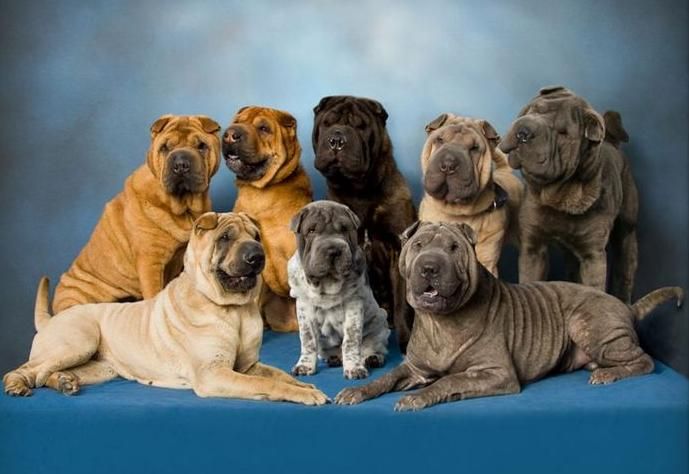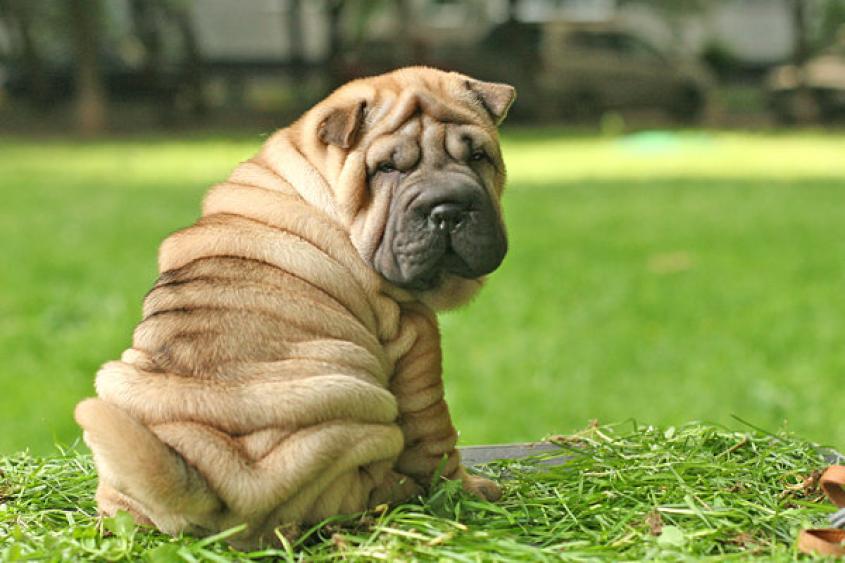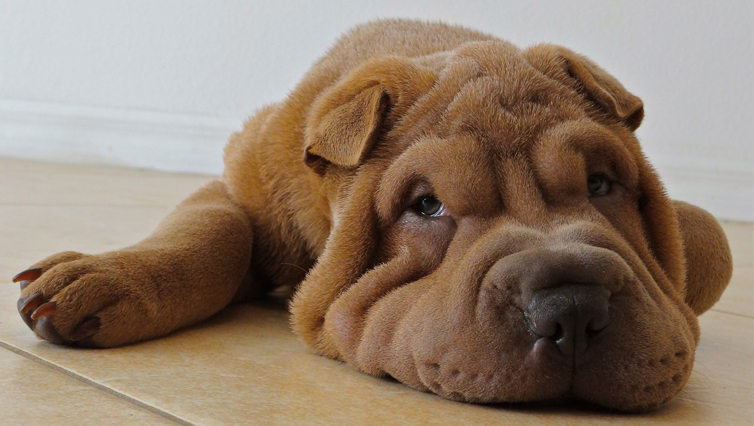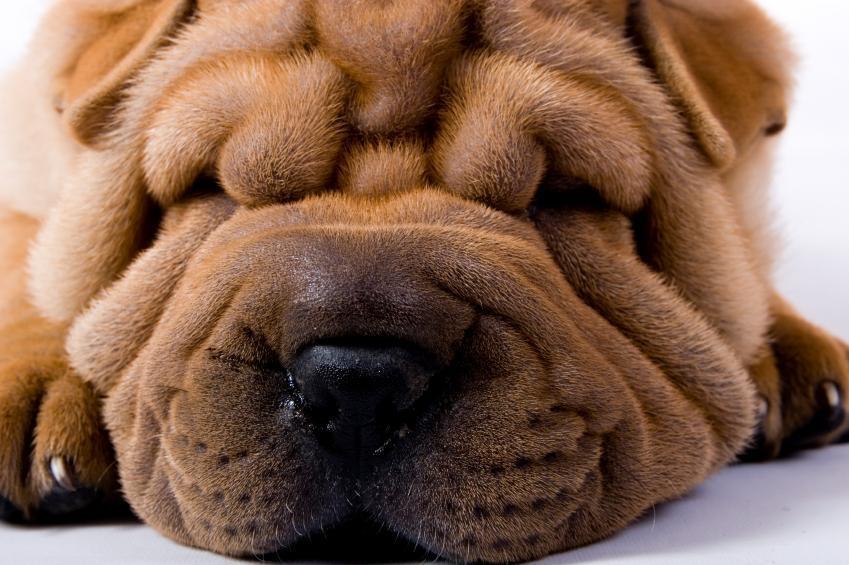The Shar-Pei is a type of dog breed known for its deep wrinkles and a blue-black tongue. The breed originates from southern China. The English name “Shar-Pei” derives from the British spelling of the older Cantonese shā pèih (沙皮, Mandarin: shā pí), which translates to “sandy skin” and refers to the texture of the breed’s short, rough coat. As puppies, Shar-Pei has numerous wrinkles, but as they mature, these loosen and spread out as they “grow into their skin”. The Shar-Pei was named in 1978 as one of the world’s rarest dog breeds by TIME magazine and Guinness World Records. Although the Shar-Pei has been identified as a basal breed that predates the emergence of the modern breeds in the 19th century.
Appearance

Small, triangle ears and a cylinder body shape give the Shar-Pei a unique look. For show standard, “the tail is thick and round at the base, tapering to a fine point”. As puppies, Shar-Pei are more wrinkly than adults and, although some adults can be wrinklier than their puppy selves, an adult Shar-Pei should have wrinkles mostly on the face, a few on the shoulder, and at the base of the tail.
Colours
The Shar-Pei’s pigmentation resembles the Chow Chow, as they have been crossbred before, probably giving the Shar-Pei the same blue-black tongue. The coat must be solid in colour, and any Shar-Pei with a “flower-coat” (white with either black or blue patches) is a disqualification. Colours include black, blue, brown, red, fawn, red-fawn, five-point red, cream, apricot, chocolate, and various sables (e.g. sables, black silver sables and black bronze sables). The nose may be black or brick (pink with black), and the face may be with or without a black mask. A Shar-Pei can also have what is called a “dilute” colouration, meaning that the nose and nails of the dog are the same colour as the coat (e.g. a chocolate coat with a chocolate nose and nails); these include cream dilute, apricot dilute, and chocolate dilute. Dilutes can also have what is called an “Isabella” colouration, meaning that there is silver shading on the coat colour. All of these colour variations are acceptable, but the coat colour must be solid and well blended throughout the whole body of the dog.
Coat

Horse-coat, rough to the touch, extremely prickly and off-standing, soft in one direction and harsh in the other; brush-coat, with long hair and a smoother feel; and bear-coat. Examples of the breed were owned by the peasant class and were used for working dogs and fighting due to their loose skin.
The Western Shar-Pei comes in three different coat types: horse-, brush-, and bear-coat. The unusual horse-coat is rough to the touch, extremely prickly and off-standing and is closer to the original traditional Shar-Pei breed in appearance and coat type than the brush- or bear-coat. This coat is fairly prickly and can be rough or irritating when petting in the opposite direction of the fur. The horse-coat is generally thought to be more active and predisposed to dominant behaviour than the brush-coat. The brush-coat variety has slightly longer hair and a smoother feel to it. The brush-coat is generally considered to be more of a “couch potato” than the horse-coat. This breed sheds normally twice a year.
Any coat longer than one inch at the withers is called a “bear-coat” and is not considered the breed standard, as it occurs only when both the male and female carry recessive coat genes. This coat length resembles the coat of the Chow Chow and was probably inherited from that breed. The personality of the bear-coat is very much like that of the brush-coat.
Some people may experience a sensitivity to the harshness of the coat of either length. This is a mild, short-lived rash that can develop on skin that has been in contact with the coat, most commonly on the forearms.
Wrinkles

The traditional Shar-Pei that is most popular in China is more faithful to the history of the breed (taller, less wrinkly, a flatter mouth and nose, horse-coated). As puppies, they have lots of wrinkles and as they get older, they have fewer wrinkles.
Scientists from the Department of Genome Sciences at the University of Washington, Seattle, announced in January 2010 that they had analysed the genetic code of 10 different pedigree dog breeds. In the Shar-Pei, they discovered four small differences located in the gene HAS2, which is responsible for making hyaluronic acid synthase 2. That enzyme makes hyaluronic acid, which is one of the key components of the skin. There have been rare cases in which a mutation of the same gene has caused severe wrinkling in humans as well: see Excess skin.
History
The Shar-Pei has been identified as a basal breed that predates the emergence of the modern breeds in the 19th century.
The Shar-Pei breed comes from the Guangdong province of China. The original Shar-Pei from China may have looked very different from the breed now popular in the West (but that has not been confirmed); in southern China, Hong Kong, and Macau the Western-type and the traditional type are differentiated by calling them, respectively, the ‘meat-mouth’ and the ‘bone-mouth’ Shar-Pei. The Guangdong province in China was also a popular trading place during the Han dynasty, and it is unclear if the Shar-Pei was brought to China, or if it was originally bred in China.
The Shar-Pei’s loose skin and extremely prickly coat were originally developed to help the dogs fend off wild boar, as they were used to hunt. Later, the breed was used for dog fighting; these enhanced traits made the Shar-Pei difficult for its opponent to grab and hold on to, and so that if it did manage to hold on, the Shar-Pei would still have room to manoeuvre and bite back; when grabbed by any loose wrinkle, a Shar-Pei can actually twist in their skin and face in their opponent’s direction. In fighting, they would twist in their skin to bite the assailant back.
During the Communist Revolution, when the Shar-Pei population dwindled dramatically, dogs were rescued by a Hong Kong businessman named Matgo Law, who in 1973 appealed to Americans through a dog magazine to save the breed. Around 200 Shar-Peis were smuggled into America. The current American Shar-Pei population stems mainly from these original 200.
